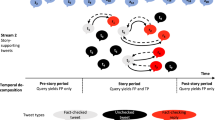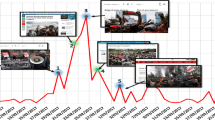Abstract
Users in social networks utilize hashtags for a variety of reasons. In many cases, hashtags serve retrieval purposes by labeling the content they accompany. More often than not, hashtags are used to promote content, ideas, or conversations producing viral memes. This paper addresses a specific case of hashtag classification: meme-filtering. We argue that hashtags that are correlated with memes may hinder many valuable social media algorithms like trend detection and event identification. We propose and evaluate a set of language-agnostic features that aid the separation of these two classes: meme-hashtags and event-hashtags. The proposed approach is evaluated on two large datasets of Twitter messages written in English and German. A proof-of-concept application of the meme-filtering approach to the problem of event detection is presented.
















Similar content being viewed by others
Notes
Obviously, there are exception to this rule. In our times, information about earthquakes appears on social media first. However, this is still related to a real-world event.
References
Aha DW, Kibler DF, Albert MK (1991) Instance-based learning algorithms. Mach Learn 6:37–66
Bauckhage C (2011) Insights into internet memes. In: ICWSM
Boyd D, Golder S, Lotan G (2010) Tweet, tweet, retweet: conversational aspects of retweeting on twitter. In: Proceedings of the 2010 43rd Hawaii international conference on system sciences, IEEE Computer Society, Washington, DC, HICSS ’10, pp 1–10. doi:10.1109/HICSS.2010.412
Burton S, Soboleva A (2011) Interactive or reactive? Marketing with twitter. J Consum Mark 28(7):491–499
Fernández-Delgado M, Cernadas E, Barro S, Amorim D (2014) Do we need hundreds of classifiers to solve real world classification problems? J Mach Learn Res 15(1):3133–3181
Grant WJ, Moon B, Busby Grant J (2010) Digital dialogue? Australian politicians’ use of the social network tool twitter. Aust J Polit Sci 45(4):579–604
Gupta A, Sycara KP, Gordon GJ, Hefny A (2013) Exploring friend’s influence in cultures in twitter. In: ASONAM, pp 584–591
Hall M, Frank E, Holmes G, Pfahringer B, Reutemann P, Witten IH (2009) The weka data mining software: an update. SIGKDD Explor Newsl 11(1):10–18
Hawn C (2009) Take two aspirin and tweet me in the morning: how twitter, facebook, and other social media are reshaping health care. Health Aff 28(2):361–368
Kamath KY, Caverlee J (2013) Spatio-temporal meme prediction: learning what hashtags will be popular where. In: Proceedings of the 22nd ACM international conference on conference on information & knowledge management, ACM, pp 1341–1350
Kamath KY, Caverlee J, Lee K, Cheng Z (2013) Spatio-temporal dynamics of online memes: A study of geo-tagged tweets. In: Proceedings of the 22nd international conference on world wide web, International World Wide Web Conferences Steering Committee, pp 667–678
Kleinberg J (2003) Bursty and hierarchical structure in streams. Data Min Knowl Discov 7(4):373–397
Kouloumpis E, Wilson T, Moore J (2011) Twitter sentiment analysis: The good the bad and the omg!. ICWSM 11:538–541
Lappas T, Arai B, Platakis M, Kotsakos D, Gunopulos D (2009) On burstiness-aware search for document sequences. In: Proceedings of the 15th ACM SIGKDD international conference on knowledge discovery and data mining, Paris, June 28–July 1, 2009, pp 477–486, doi:10.1145/1557019.1557075
Leskovec J, Backstrom L, Kleinberg J (2009) Meme-tracking and the dynamics of the news cycle. In: Proceedings of the 15th ACM SIGKDD international conference on Knowledge discovery and data mining, ACM, pp 497–506
Parker J, Wei Y, Yates A, Frieder O, Goharian N (2013) A framework for detecting public health trends with twitter. In: ASONAM, pp 556–563
Petrovic S, Osborne M, McCreadie R, Macdonald C, Ounis I, Shrimpton L (2013) Can twitter replace newswire for breaking news. In: Seventh international AAAI conference on weblogs and social media
Platakis M, Kotsakos D, Gunopulos D (2009) Searching for events in the blogosphere. In: Proceedings of the 18th international conference on world wide web, ACM, pp 1225–1226
Qi X, Tang W, Wu Y, Guo G, Fuller E, Zhang CQ (2014) Optimal local community detection in social networks based on density drop of subgraphs. Pattern Recogn Lett 36:46–53
Quercia D, Kosinski M, Stillwell D, Crowcroft J (2011) Our twitter profiles, our selves: Predicting personality with twitter. In: Privacy, security, risk and trust (passat), 2011 IEE third international conference on social computing (socialcom), pp 180–185
Ruzzo WL, Tompa M (1999) A linear time algorithm for finding all maximal scoring subsequences. ISMB 99:234–241
Sen S, Lam SK, Rashid AM, Cosley D, Frankowski D, Osterhouse J, Harper FM, Riedl J (2006) Tagging, communities, vocabulary, evolution. In: Proceedings of the 2006 20th anniversary conference on Computer supported cooperative work, ACM, pp 181–190
Teevan J, Ramage D, Morris MR (2011) # twittersearch: a comparison of microblog search and web search. In: Proceedings of the fourth ACM international conference on Web search and data mining, ACM, pp 35–44
Tsur O, Rappoport A (2012) What’s in a hashtag?: content based prediction of the spread of ideas in microblogging communities. In: Proceedings of the fifth ACM international conference on Web search and data mining, ACM, pp 643–652
Valkanas G, Gunopulos D (2013) How the live web feels about events. In: Iyengar A, Nejdl W, Pei J, Rastogi R, He Q (eds) CIKM, ACM, pp 639–648
Yang J, Leskovec J (2011) Patterns of temporal variation in online media. In: Proceedings of the fourth ACM international conference on Web search and data mining, ACM, pp 177–186
Acknowledgments
The authors would like to thank the data annotators. This work has been co-financed by EU and Greek National funds through the Operational Program “Education and Lifelong Learning” of the National Strategic Reference Framework (NSRF) - Research Funding Programs: Heraclitus II fellowship, THALIS - GeomComp, THALIS - DISFER, ARISTEIA - MMD,” and the EU funded project INSIGHT.
Author information
Authors and Affiliations
Corresponding author
Rights and permissions
About this article
Cite this article
Kotsakos, D., Sakkos, P., Katakis, I. et al. Language agnostic meme-filtering for hashtag-based social network analysis. Soc. Netw. Anal. Min. 5, 28 (2015). https://doi.org/10.1007/s13278-015-0271-3
Received:
Accepted:
Published:
DOI: https://doi.org/10.1007/s13278-015-0271-3




